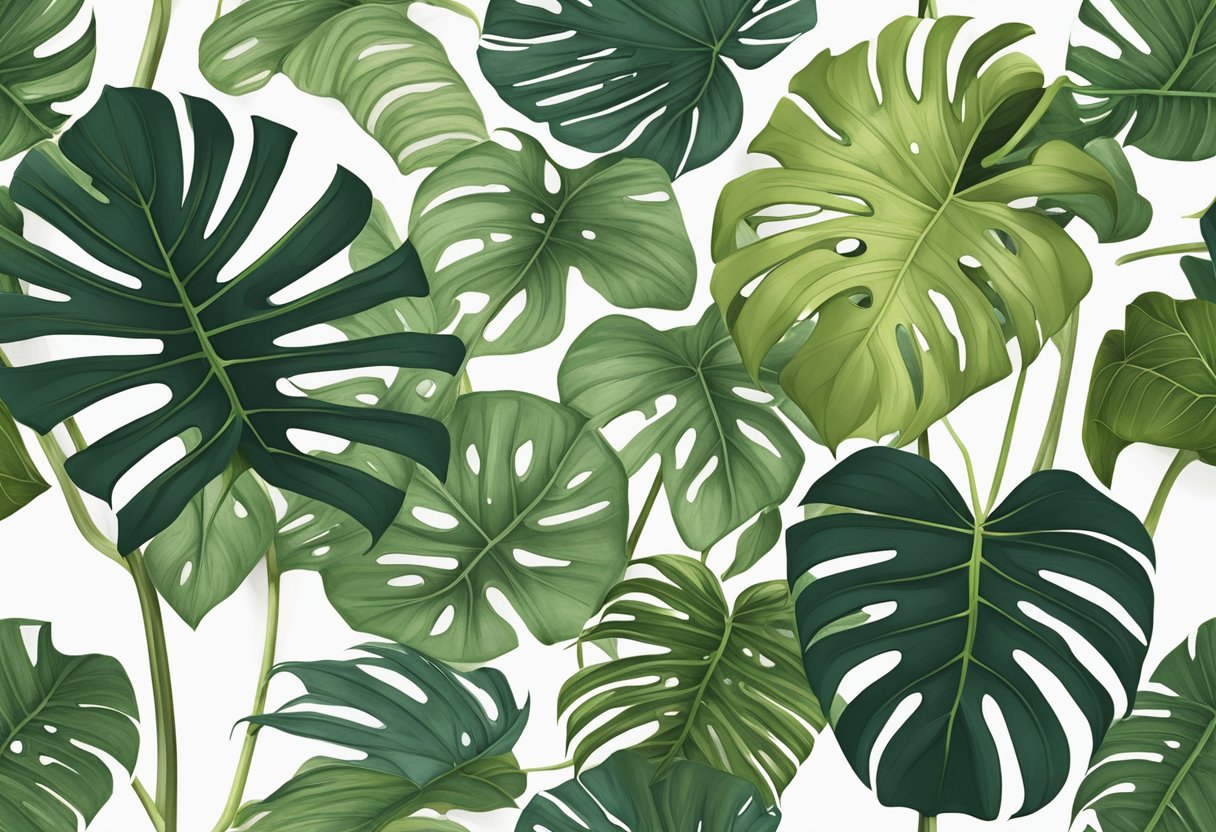Types Of Monstera
Monstera, also known as the Swiss cheese plant, is a popular houseplant that has become a staple in many homes. With its lush green foliage and unique holey leaves, it’s no wonder why so many people are drawn to this tropical beauty. There are many different types of Monstera, each with its own unique characteristics and care requirements.
In this article, we will explore the different types of Monstera, their physical characteristics, and how to care for them. Whether you’re a seasoned plant parent or a beginner, this guide will provide you with all the information you need to successfully grow and care for your Monstera.
Key Takeaways:
- There are many different types of Monstera, each with its own unique characteristics and care requirements.
- Monstera plants are popular houseplants that can add a touch of tropical beauty to any home.
- Proper care is essential for the health and longevity of your Monstera plant.
Monstera Varieties Overview

Monstera plants are known for their unique foliage and are highly sought after by plant enthusiasts. There are many different varieties of Monstera, each with its own distinct characteristics. In this section, we will provide an overview of some of the most popular Monstera varieties, including Monstera Deliciosa, Monstera Adansonii, and Monstera Obliqua.
Monstera Deliciosa
Monstera Deliciosa, also known as the Swiss Cheese Plant, is one of the most popular Monstera varieties. It is known for its large, glossy, heart-shaped leaves with distinctive splits and holes. This plant can grow up to 10 feet tall and is native to the rainforests of Central America. It is a relatively easy plant to care for and can thrive in a variety of indoor environments.
Monstera Adansonii
Monstera Adansonii, also known as the Swiss Cheese Vine, is a smaller variety of Monstera that is perfect for hanging baskets. It is known for its delicate, heart-shaped leaves with distinctive splits and holes. This plant can grow up to 20 feet long and is native to Central and South America. It is a relatively easy plant to care for and can thrive in a variety of indoor environments.
Monstera Obliqua
Monstera Obliqua is one of the rarest and most sought-after Monstera varieties. It is known for its delicate, lacy leaves with distinctive splits and holes. This plant is native to the rainforests of Central and South America and is extremely difficult to find in the wild. It is also difficult to grow and care for, making it a prized possession for many plant enthusiasts.
Overall, there are many different Monstera varieties to choose from, each with its own unique characteristics and care requirements. Whether you are looking for a large, showy plant like the Monstera Deliciosa or a small, delicate plant like the Monstera Adansonii, there is a Monstera variety that is perfect for you.
Physical Characteristics
Monstera plants are known for their unique and attractive physical characteristics. They have large, glossy, and heart-shaped leaves that can grow up to 3 feet long. The leaves have a soft texture and are dark green in color, making them an excellent addition to any indoor space.
Leaf Fenestrations
One of the most distinctive features of the Monstera plant is its leaf fenestrations. Fenestrations are the perforations or holes found in the leaves of the plant. Monstera plants have large oval-shaped holes in their leaves that can take up to 50% of the leaf surface. These perforations not only add to the plant’s aesthetic appeal but also serve a functional purpose. They allow the plant to tolerate windy conditions by reducing wind resistance, which helps prevent damage to the plant.
Growth Patterns
Monstera plants are known for their fast growth rate and can grow up to 10-15 feet tall indoors. They are climbers by nature and can be trained to grow up a trellis or other support structure. Monstera plants can also be grown as trailing plants, making them ideal for hanging baskets. They prefer bright, indirect sunlight and a well-draining soil mix.
In conclusion, Monstera plants are an excellent choice for indoor plant enthusiasts due to their unique physical characteristics, including large, glossy, and heart-shaped leaves with perforations. They are fast-growing and can be trained to grow up a trellis or trail in a hanging basket.
Caring for Monsteras
Monsteras are easy-to-care-for houseplants with big, beautiful leaves and unique hole formations. Here are some tips on how to properly care for your Monstera plant.
Soil and Watering Needs
Monsteras prefer moist soil with good drainage. It is important to ensure that the soil is not too wet or too dry. Overwatering can lead to root rot, while under-watering can cause the leaves to wilt and turn yellow. Water your Monstera when the top inch of soil feels dry to the touch. Use a well-draining soil mix and a pot with ample drainage holes to prevent water from accumulating in the soil.
Light and Temperature
Monsteras prefer bright, indirect light. Direct sunlight can scorch the leaves, while low light can cause the plant to grow slowly and produce smaller leaves. Place your Monstera near a window that receives bright, indirect light. Monsteras thrive in warm, humid environments and prefer temperatures between 65 and 85 degrees Fahrenheit.
Pruning and Potting
Monsteras are fast-growing plants and can become quite large if left unpruned. Regular pruning can help control the size and shape of the plant. Use clean, sharp pruning shears to remove any dead or damaged leaves, or to shape the plant as desired. Repot your Monstera every 1-2 years, or when the roots have outgrown the pot. Use a pot that is one size larger than the current pot, and add fresh soil mix to the bottom of the pot before placing the plant in the new pot.
Overall, Monsteras are low-maintenance plants that can add a touch of tropical beauty to any indoor space. By following these simple care tips, you can enjoy your Monstera for years to come.
Common Challenges
Monstera plants are generally easy to care for, but they can still face some challenges. Here are some common issues to look out for when caring for your Monstera plant.
Pests and Diseases
Like all plants, Monstera plants can be susceptible to pests and diseases. The most common pests that can attack Monstera plants include spider mites, mealybugs, and scale insects. These pests can cause damage to the leaves and stems of the plant, and can also spread to other plants in your home.
To prevent pests from attacking your Monstera plant, it is important to keep the plant clean and free of debris. You can also use insecticidal soap or neem oil to treat any pests that do appear on your plant.
Monstera plants can also be susceptible to fungal diseases, such as root rot and leaf spot. These diseases can cause the leaves to turn yellow and wilt, and can eventually kill the plant. To prevent fungal diseases, it is important to ensure that the soil is well-draining and that the plant is not overwatered.
Toxicity to Pets
Monstera plants are toxic to pets, including dogs and cats. The plant contains calcium oxalate crystals, which can cause irritation and swelling in the mouth, throat, and digestive tract if ingested.
To keep your pets safe, it is important to keep your Monstera plant out of reach. If you notice that your pet has ingested any part of the plant, you should contact your veterinarian immediately.
In conclusion, while Monstera plants are generally easy to care for, they can still face some challenges. By keeping an eye out for pests and diseases, and keeping your plant out of reach of pets, you can help ensure that your Monstera plant stays healthy and beautiful.
Decorative and Practical Uses
Monstera plants are not just beautiful to look at, they also serve practical purposes. Here are some decorative and practical uses of these tropical beauties:
Indoor Gardening Aesthetics
Monstera plants are popular indoor plants that add a touch of greenery to any space. They are easy to care for and can thrive in low-light conditions. They are also versatile and can be grown in a variety of containers, including hanging baskets, pots, and terrariums. In addition, their unique leaf structure and size make them a perfect statement piece for any room.
Support Structures
Monstera plants are climbing plants that require support structures to grow properly. They can be trained to grow up trellises, poles, or other support structures. This not only helps the plant grow in a healthy manner, but it also adds an interesting element to any space. Monstera plants are evergreen vines that can grow up to 20 feet long, making them a great choice for creating a lush, tropical look in any room.
When choosing a support structure for your Monstera plant, it’s important to consider the size of the plant and the space it will be in. A trellis or pole should be sturdy enough to support the weight of the plant and should be placed in a location that allows the plant to grow freely.
Overall, Monstera plants are a great choice for anyone looking to add some greenery to their indoor space. They are easy to care for, versatile, and can be used in a variety of decorative and practical ways.






